1) Which of the following is (are) true of natural selection?
A) It requires genetic variation, results in descent with
modification, and involves differential reproductive success.
B)
It involves differential reproductive success.
C) It requires
genetic variation.
D) It results in descent with modification.
A)
2) Cotton-topped tamarins are small primates with tufts of long white hair on their heads. While studying these creatures, you notice that males with longer hair get more opportunities to mate and father more offspring. To test the hypothesis that having longer hair is adaptive in these males, you should _____.
A) test whether other traits in these males are also
adaptive
B) test whether males with shaved heads are still able
to mate
C) look for evidence of hair in ancestors of
tamarins
D) determine if hair length is heritable
D)
3) A salamander relies on hydrogen bonding to stick to various surfaces. Therefore, a salamander would have the greatest difficulty clinging to a _____.
A) surface of mostly carbon-oxygen bonds
B) surface of mostly carbon-nitrogen bonds
C) surface of hydrocarbons
D) slightly damp surface
C)
Use the following information when answering the corresponding
question(s).
In 1668, Francesco Redi performed a series of
experiments on spontaneous generation. He began by putting similar
pieces of meat into eight identical jars. Four jars were left open to
the air, and four were sealed. He then did the same experiment with
one variation: Instead of sealing four of the jars completely, he
covered them with gauze (the gauze excluded the flies while allowing
the meat to be exposed to air). In both experiments, he monitored the
jars and recorded whether or not maggots (young flies) appeared in the
meat.
4) Refer to the paragraph on Redi's experiments. In both
experiments, flies appeared in all of the open jars and only in the
open jars. Which one of the following statements is correct?
A) The experiment was inconclusive because Redi used only one
kind of meat.
B) The experiment supports the hypothesis that
maggots arise only from eggs laid by adult flies.
C) The
experiment was inconclusive because it did not run long
enough.
D) The experiment supports the hypothesis that
spontaneous generation occurs in rotting meat.
B)
5) Agrobacterium infects plants and causes them to form tumors. You
are asked to determine how long a plant must be exposed to these
bacteria to become infected. Which of the following experiments will
provide the best data to address that question?
A) Measure the
number of tumors formed on a plant when exposed to various
concentrations of Agrobacterium.
B) Measure the number of tumors
formed on plants, which are exposed to Agrobacterium for different
lengths of time.
C) Determine the survival rate of Agrobacterium
when exposed to different concentrations of an antibiotic.
D)
Measure the concentration of Agrobacterium in different soil
environments where the plants grow.
B)
6) Water molecules can form hydrogen bonds with _____.
A) oxygen gas (O2) molecules
B) chloride ions
C) oils
D) compounds that have polar covalent bonds
D)
7) You have a freshly prepared 0.1 M glucose solution. Each liter of this solution contains how many glucose molecules?
A) 6.02 × 1024
B) 6.02 × 1022
C) 6.02 × 1023
D) 3.01 × 1023
B)
8) The cities of Portland, Oregon, and Minneapolis, Minnesota, are at about the same latitude, but Minneapolis has much hotter summers and much colder winters than Portland. Why?
A) The ocean near Portland moderates the temperature.
B)
They are not at the same exact latitude.
C) Fresh water is more
likely to freeze than salt water.
D) Minneapolis is much
windier, due to its location in the middle of North America.
A)
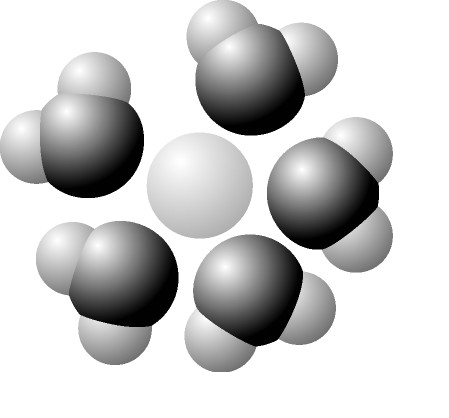
9) Based on your knowledge of the polarity of water molecules, the
solute molecule depicted here is most likely _____.
A) nonpolar
B) without charge
C) positively charged
D) negatively charged
C)
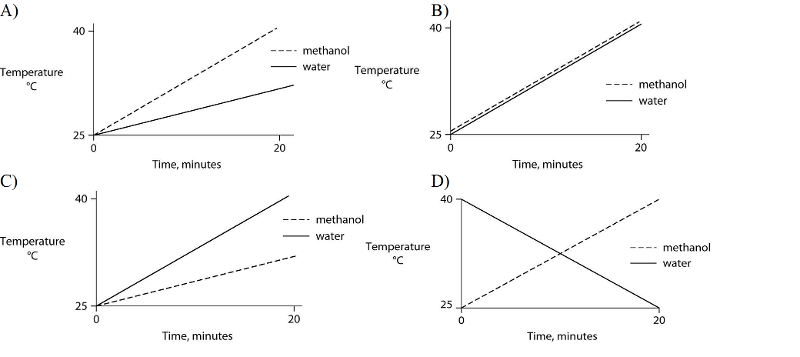
10) Identical heat lamps are arranged to shine on two identical containers, one containing water and one methanol (wood alcohol), so that each liquid absorbs the same amount of energy minute by minute. The covalent bonds of methanol molecules are nonpolar, so there are no hydrogen bonds among methanol molecules. Which of the following graphs correctly describes what will happen to the temperature of the water and the methanol?
A)
11) A solution with a pH of 5 has how many more protons in it than a
solution with a pH of 7?
A) 10 times B) 5 times C) 100 times D)
1000 times
C)
12) A solution contains 0.0000001 (10-7) moles of hydroxyl ions [OH-] per liter. Which of the following best describes this solution?
A) basic: H+ acceptor
B) acidic: H+ donor
C) acidic: H+ acceptor
D) neutral
D)
13) Which of the following molecules is polar?
C3H7OH C2H5COOH
A) Neither C2H5COOH or C3H7OH is polar.
B) C3H7OH and
C2H5COOH are both polar molecules.
C) C3H7OH is not polar, but
C3H7OH is polar.
D) C2H5COOH is polar, but C3H7OH is not polar.
B)
14) A compound contains hydroxyl groups as its predominant functional group. Therefore, this compound ___.
A) lacks an asymmetric carbon and is probably a fat or
lipid
B) will not form hydrogen bonds with water
C) should
dissolve in a nonpolar solvent
D) should dissolve in water
D)

15) Which functional group shown above is characteristic of alcohols?
A) A B) B C) C D) D
A)
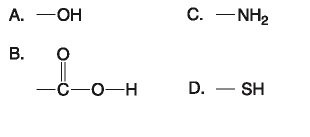
16) Which functional group(s) shown above is (are) present in all amino acids?
A) A and B B) B and D
C) C only D) B and C
D)
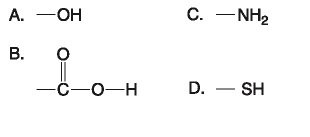
17) Which of the groups shown above is a functional group that helps stabilize proteins by forming covalent cross-links within or between protein molecules?
A) A B) B C) C D) D
D)
18) How do phospholipids interact with water molecules?
A) The polar heads interact with water; the nonpolar tails do
not.
B) Phospholipids dissolve in water.
C) The polar heads
avoid water; the nonpolar tails attract water (because water is polar
and opposites attract).
D) Phospholipids do not interact with
water because water is polar and lipids are nonpolar.
A)
19) A glycosidic linkage is analogous to which of the following in proteins?
A) a β-pleated sheet B) a disulfide bond C) a peptide bond D) an amino group
C)
20) Which of the following is the strongest evidence that protein structure and function are correlated?
A) Proteins have four distinct levels of structure and many
functions.
B) Denatured (unfolded) proteins do not function
normally.
C) Proteins function best at certain
temperatures.
D) Enzymes tend to be globular in shape.
B)
21) Tay-Sachs disease is a human genetic abnormality that results in cells accumulating and becoming clogged with very large, complex, undigested lipids. Which cellular organelle must be involved in this condition?
A) the lysosome B) the Golgi apparatus C) mitochondrion D) the endoplasmic reticulum
A)
22) The R-group, or side chain, of the amino acid serine is -CH2-OH. The R-group, or side chain, of the amino acid leucine is -CH2-CH-(CH3)2. Where would you expect to find these amino acids in a globular protein in aqueous solution?
A) Serine and leucine would both be in the interior of the
globular protein.
B) Serine and leucine would both be on the
exterior of the globular protein.
C) Leucine would be in the
interior, and serine would be on the exterior of the globular
protein.
D) Serine would be in the interior, and leucine would
be on the exterior of the globular protein.
C)
23) Changing a single amino acid in a protein consisting of 325 amino acids would _____.
A) alter the primary structure of the protein but not its
tertiary structure or function
B) always alter the biological
activity or function of the protein
C) cause the tertiary
structure of the protein to unfold
D) always alter the primary
structure of the protein, sometimes alter the tertiary structure of
the protein, and sometimes affect its biological activity
D)
24) If a DNA sample were composed of 10% thymine, what would be the percentage of guanine?
A) 10 B) 80 C) 40 D) It is impossible to tell from the information given.
C)
25) A new organism is discovered in the forests of Costa Rica. Scientists there determine that the polypeptide sequence of hemoglobin from the new organism has 72 amino acid differences from humans, 65 differences from a gibbon, 49 differences from a rat, and 5 differences from a frog. These data suggest that the new organism is more closely related to
A) rats than to frogs B) gibbons than to rats
C) humans than
to frogs D) frogs than to humans
D)
26) What is the reason that a modern transmission electron microscope (TEM) can resolve biological images to the subnanometer level, as opposed to tens of nanometers achievable for the best super-resolution light microscope?
A) The electron microscope has a much greater ratio of image size to
real size.
B) Electron beams have much shorter wavelengths than
visible light.
C) The focal length of the electron microscope is
significantly longer.
D) Contrast is enhanced by staining with
atoms of heavy metal.
B)
27) What is the most likely pathway taken by a newly synthesized protein that will be secreted by a cell?
A) ER → Golgi → nucleus
B) ER → lysosomes → vesicles that
fuse with plasma membrane
C) ER → Golgi → vesicles that fuse
with plasma membrane
D) Golgi → ER → lysosome
C)
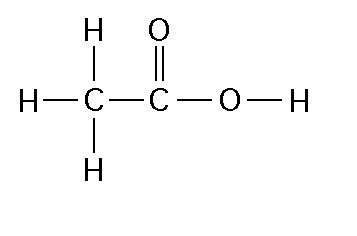
28) How many grams of the compound in the figure above are required to make 1 liter of a 0.5 M solution? (Note: The atomic masses, in daltons, are approximately 12 for carbon, 1 for hydrogen, and 16 for oxygen.)
A) 30 B) 29 C) 60 D) 150
A)
30) Suppose a cell has the following molecules and structures:
enzymes, DNA, ribosomes, plasma membrane, and mitochondria. It could
be a cell from _____.
A) an animal but not a plant B) nearly any
eukaryotic organism C) a plant but not an animal D) a bacterium
B)
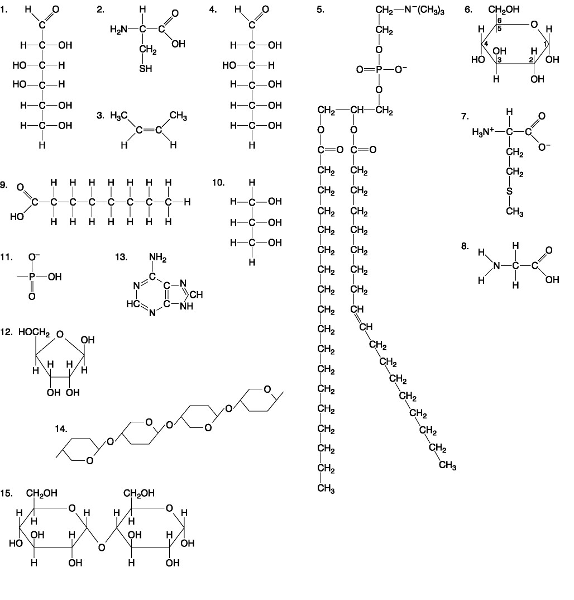
31) Which molecule has both hydrophilic and hydrophobic properties and is found in plasma membranes?
A) 14 B) 5 C) 12 D) 1
B)
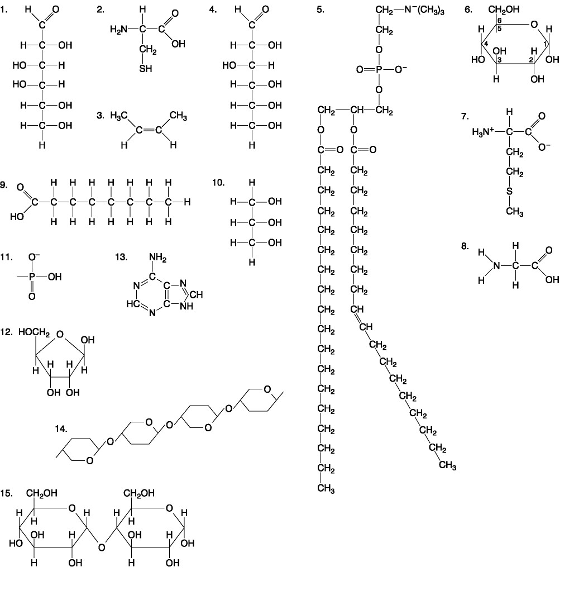
32) Which of the following combinations of molecules illustrated could be linked to form a nucleotide?
A) 11, 12, and 13
B) 1, 2, and 11
C) 5, 9, and 10
D) 3, 7, and 8
A)
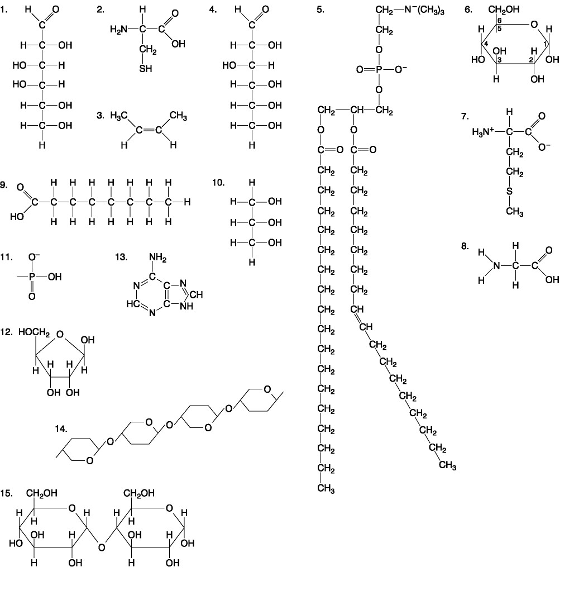
33) Which molecule is a saturated fatty acid?
A) 9
B) 8
C) 5
D) 1
A)
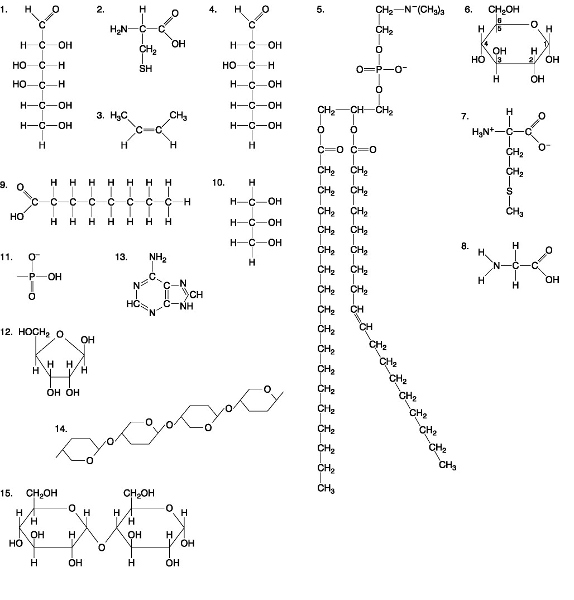
34) Which of the following molecules is a purine nitrogenous base?
A) 12
B) 13
C) 2
D) 5
B)
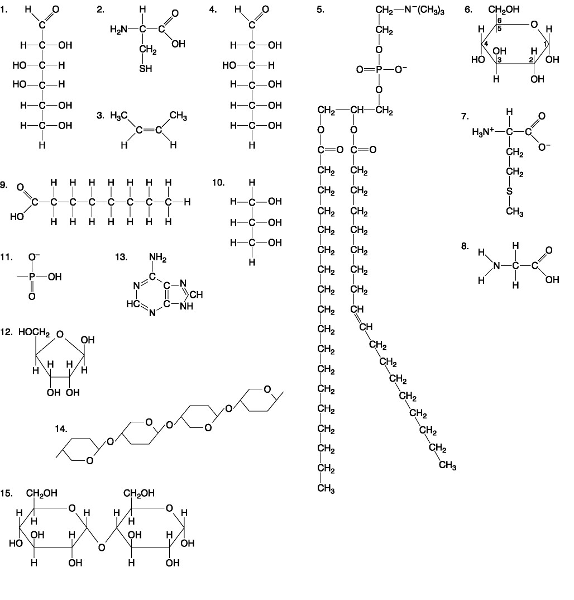
35) Which of the following molecules act as building blocks (monomers) of polypeptides?
A) 7, 8, and 13
B) 2, 7, and 8
C) 11, 12, and 13
D) 1, 4, and 6
B)
36) Large numbers of ribosomes are present in cells that specialize in producing which of the following molecules?
A) nucleic acids
B) proteins
C) glycogen
D) lipids
B)
37) What is the function of the nuclear pore complex found in eukaryotes?
A) It assembles ribosomes from raw materials that are synthesized
in the nucleus.
B) It synthesizes the proteins required to copy
DNA and make mRNA.
C) It regulates the movement of proteins and
RNAs into and out of the nucleus.
D) It selectively transports
molecules out of the nucleus, but prevents all inbound molecules from
entering the nucleus.
C)
38) Asbestos is a material that was once used extensively in construction. One risk from working in a building that contains asbestos is the development of asbestosis caused by the inhalation of asbestos fibers. Cells will phagocytize asbestos, but are not able to degrade it. As a result, asbestos fibers accumulate in _____.
A) peroxisomes B) lysosomes C) mitochondria D) ribosomes
B)
39) Which organelle is the primary site of ATP synthesis in eukaryotic cells?
A) Golgi apparatus B) mitochondrion C) lysosome D) peroxisome
B)
40) In a plant cell, DNA may be found _____.
A) in the nucleus, mitochondria, chloroplasts, and
peroxisomes
B) only in the nucleus and chloroplasts
C) in
the nucleus, mitochondria, and chloroplasts
D) only in the nucleus
C)
41) The evolution of eukaryotic cells most likely involved _____.
A) acquisition of an endomembrane system and subsequent evolution
of mitochondria from a portion of the Golgi
B) anaerobic archaea
taking up residence inside a larger bacterial host cell to escape
toxic oxygen—the anaerobic bacterium evolved into chloroplasts
C)
endosymbiosis of an aerobic bacterium in a larger host cell—the
endosymbiont evolved into mitochondria
D) an endosymbiotic fungal
cell evolving into the nucleus
C)
42) Where are proteins produced other than on ribosomes free in the cytosol or ribosomes attached to the ER?
A) in the nucleolus
B) in the extracellular matrix
C) in the Golgi apparatus
D) in mitochondria
D)
43) Researchers tried to explain how vesicular transport occurs in cells by attempting to assemble the transport components. They set up microtubular tracks along which vesicles could be transported, and they added vesicles and ATP (because they knew the transport process requires energy). Yet, when they put everything together, there was no movement or transport of vesicles. What were they missing?
A) endoplasmic reticulum
B) motor proteins
C) an axon
D) contractile microfilaments
B)
44) Which of the following statements about the cytoskeleton is true?
A) Chemicals that block the assembly of the cytoskeleton would
have little effect on a cell's response to external stimuli.
B)
Although microtubules are common within a cell, actin filaments are
rarely found outside of the nucleus.
C) Movement of cilia and
flagella is the result of motor proteins causing microtubules to move
relative to each other.
D) The cytoskeleton of eukaryotes is a
static structure most resembling scaffolding used at construction sites.
C)
45) Plasmodesmata in plant cells are most similar in function to which of the following structures in animal cells?
A) extracellular matrix
B) gap junctions
C) tight junctions
D) desmosomes
B)
46) Where would you expect to find tight junctions?
A) in the epithelium of an animal's stomach
B) between the
smooth endoplasmic reticulum and the rough endoplasmic
reticulum
C) in the plasma membrane of prokaryotes
D)
between plant cells in a woody plant
A)
47) H. V. Wilson worked with sponges to gain some insight into exactly what was responsible for holding adjacent cells together. He exposed two species of differently pigmented sponges to a chemical that disrupted the cell-cell interaction (cell junctions), and the cells of the sponges dissociated. Wilson then mixed the cells of the two species and removed the chemical that caused the cells to dissociate. Wilson found that the sponges reassembled into two separate species. The cells from one species did not interact or form associations with the cells of the other species. How do you explain the results of Wilson's experiments?
A) The two species of sponge had different enzymes that
functioned in the reassembly process.
B) The molecules
responsible for cell-cell adhesion (cell junctions) differed between
the two species of sponge.
C) The molecules responsible for
cell-cell adhesion (cell junctions) were irreversibly destroyed
during the experiment.
D) One cell functioned as the nucleus for
each organism, thereby attracting only cells of the same pigment.
B)
48) Gaucher disease is the most common of lipid storage diseases in humans. It is caused by a deficiency of an enzyme necessary for lipid metabolism. This leads to a collection of fatty material in organs of the body including the spleen, liver, kidneys, lungs, brain, and bone marrow. Using your knowledge of the structure of eukaryotic cells, identify the statement below that best explains how internal membranes and the organelles of cells would be involved in Gaucher disease.
A) The lysosomes lack sufficient amounts of enzymes necessary for
the metabolism of lipids.
B) The rough endoplasmic reticulum
contains too many ribosomes which results in an overproduction of the
enzyme involved in carbohydrate catalysis.
C) The mitochondria
are most likely defective and do not produce adequate amounts of ATP
needed for cellular respiration.
D) The Golgi apparatus produces
vesicles with faulty membranes that leak their contents into the
cytoplasm of the cell.
A)

49) Both the volume and the surface area for three different cells were measured. These values are listed in the following table:
Using data from the table above, select the best explanation for why that cell will be able to eliminate waste most efficiently?
A) Cell 3 because it is big enough to allow wastes to easily
diffuse through the plasma membrane.
B) Cell 1 since it has the
smallest volume and will not produce as much waste as the other
cells.
C) Cell 3 since it has the largest surface area which
will enable it to eliminate all of its wastes quickly.
D) Cell 2
since it has the highest surface area-to-volume ratio which
facilitates the exchange of materials between a cell and its environment.
D)
50) Which of the following best summarizes the relationship between dehydration reactions and hydrolysis?
A) Dehydration reactions assemble polymers; hydrolysis reactions
break polymers apart.
B) Dehydration reactions and hydrolysis
reactions assemble polymers from monomers.
C) Hydrolysis
reactions create polymers and dehydration reactions create
monomers.
D) Dehydration reactions eliminate water from
membranes; hydrolysis reactions add water
A)